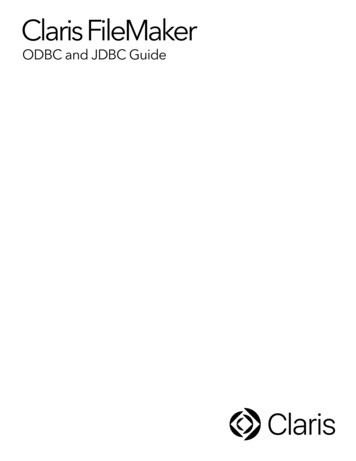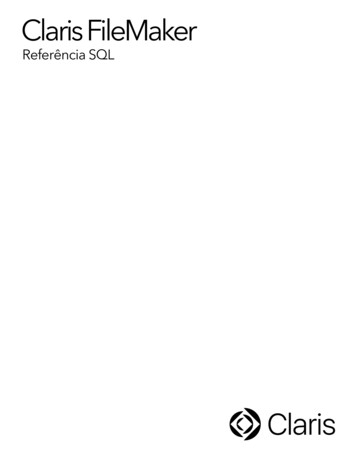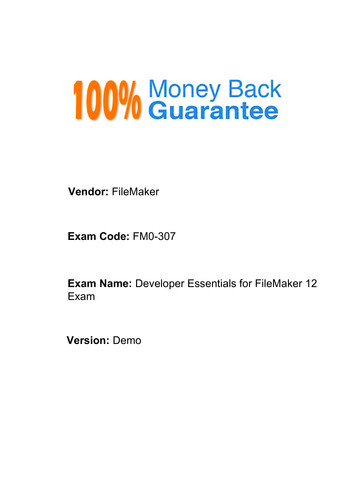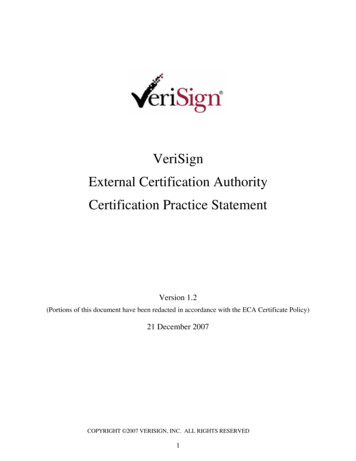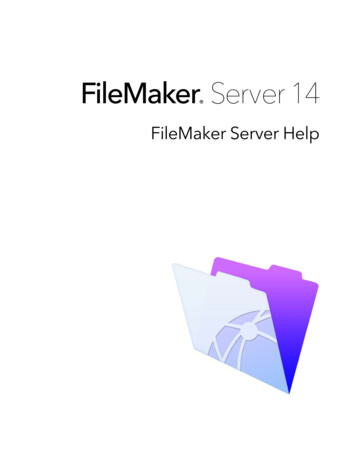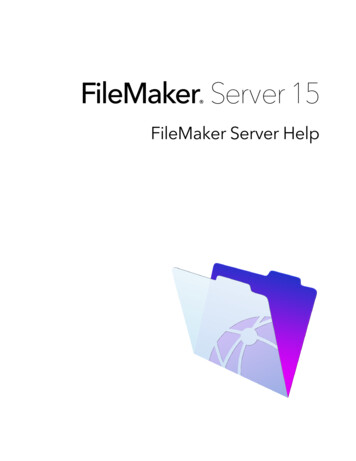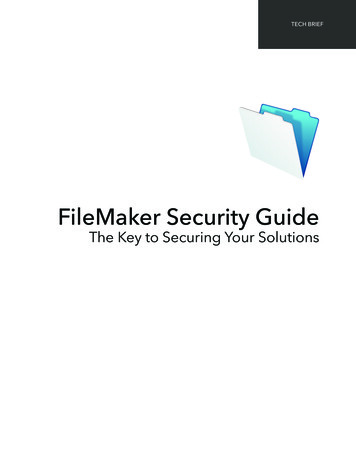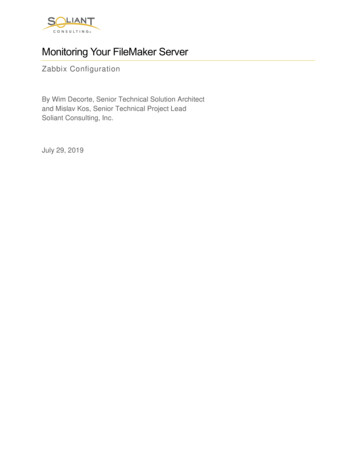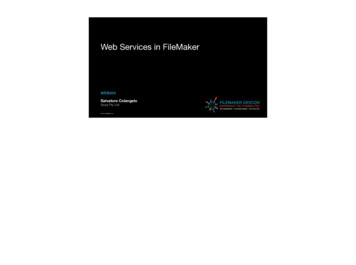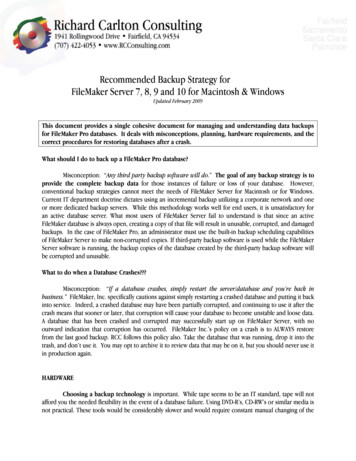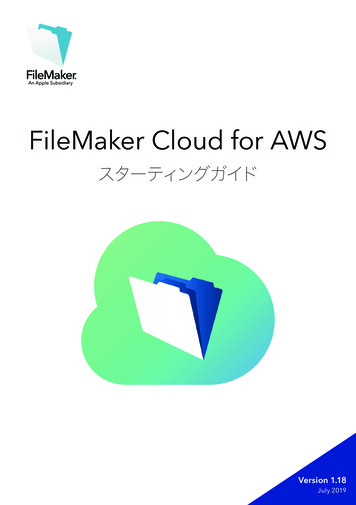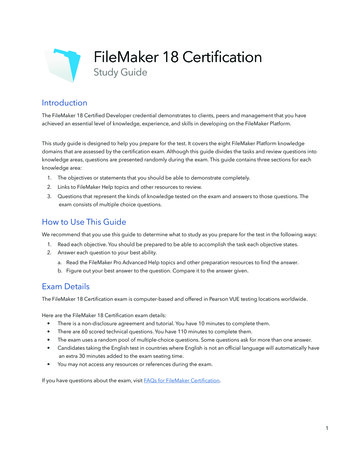
Transcription
FileMaker 18 CertificationStudy GuideIntroductionThe FileMaker 18 Certified Developer credential demonstrates to clients, peers and management that you haveachieved an essential level of knowledge, experience, and skills in developing on the FileMaker Platform.This study guide is designed to help you prepare for the test. It covers the eight FileMaker Platform knowledgedomains that are assessed by the certification exam. Although this guide divides the tasks and review questions intoknowledge areas, questions are presented randomly during the exam. This guide contains three sections for eachknowledge area:1.The objectives or statements that you should be able to demonstrate completely.2.Links to FileMaker Help topics and other resources to review.3.Questions that represent the kinds of knowledge tested on the exam and answers to those questions. Theexam consists of multiple choice questions.How to Use This GuideWe recommend that you use this guide to determine what to study as you prepare for the test in the following ways:1.Read each objective. You should be prepared to be able to accomplish the task each objective states.2.Answer each question to your best ability.a. Read the FileMaker Pro Advanced Help topics and other preparation resources to find the answer.b. Figure out your best answer to the question. Compare it to the answer given.Exam DetailsThe FileMaker 18 Certification exam is computer-based and offered in Pearson VUE testing locations worldwide.Here are the FileMaker 18 Certification exam details: There is a non-disclosure agreement and tutorial. You have 10 minutes to complete them. There are 60 scored technical questions. You have 110 minutes to complete them. The exam uses a random pool of multiple-choice questions. Some questions ask for more than one answer. Candidates taking the English test in countries where English is not an official language will automatically havean extra 30 minutes added to the exam seating time. You may not access any resources or references during the exam.If you have questions about the exam, visit FAQs for FileMaker Certification.1
1. Technical Specifications5 - 10 % Describe the product technical specifications for the FileMaker 18 Platform. Identify the browsers that are supported for FileMaker WebDirect. Describe the available web publishing options for FileMaker Server (e.g., FileMaker WebDirect, CWP, PHP, Describe which live back-end data sources are supported for ESS. Describe the key elements of deploying a custom app using the FileMaker iOS App SDK.FileMaker API, etc.).Preparation resourcesTechnical SpecificationsFileMaker Server Technical SpecificationsFileMaker Pro and Pro Advanced Technical SpecificationsFileMaker Go Technical SpecificationsFileMaker Knowledge Base articlesWhich ODBC data sources/drivers are supported with External SQL Data Sources?iOS App SDK InstructionsQuestions1.What are the system requirements for FileMaker Pro and FileMaker Server?2.What are the supported browsers for FileMaker WebDirect?3.What are the supported external SQL data sources?Answers1.The FileMaker platform is supported ona. FileMaker Serveri. Windows Server 2016 Datacenter Edition and Standard Edition (with Desktop Experience)ii. Windows Server 2012 R2 Standard Edition with Updateiii. macOS Mojave 10.14iv. macOS High Sierra 10.13b. FileMaker Proi.Windows 10 Pro Edition and Enterprise Editionii. Windows 8.1 Standard Edition and Pro Editioniii. Windows 7 SP1 Pro Edition and Ultimate Editioniv. macOS Mojave 10.14v. macOS High Sierra 10.132.FileMaker WebDirecti.Safari 12.xii. Mobile Safari iOS 12.x minimumiii. Chrome 73 minumumiv. Mobile: Chrome 73 on Android 7.x minimumv. Internet Explorer 11.xvi. Microsoft Edge 442
3.The supported external SQL data sources are:a. Microsoft SQL Server 2017, 2016, 2014b. MySQL Community Server 5.7.21c. Oracle 12c R2, 12c R1, 11gR2d. IBM i 7.3 (AS/400), DB2 version 11.1e. PostgreSQL 9.6.12f.Note: IBM and Postgres are not supported in FileMaker Cloud for AWS.3
2. Defining Database Schema10 – 15 % Describe and apply auto-entry options. Describe the field types available in FileMaker. Identify the mechanisms and behaviors of validation options and describe the possible outcomes when one Use a storage option to achieve a desired result. Given a particular relationships graph and scenario, define a result. Given a scenario, define the appropriate relationship to achieve a desired result. Use ESS to integrate data from an external data source and properly design a schema.is triggered.Preparation resourcesGuideFileMaker Go Development GuideFileMaker Pro Advanced Help topics and subtopicsDefining and changing fieldsSetting options for FieldsAbout container fieldsWorking with related tablesAccessing external data sourcesQuestions1.What are five of the auto-entry options available for fields?2.The auto-entry field options for a calculated value include a checkbox that says “Do not replace existingvalue (if any).” How does unchecking this box change the field’s behavior?3.What is an index for a field? Describe the two indexes available in FileMaker Pro 18 Advanced. Are therefield types that cannot be indexed?4.What methods of setting a field with data are not considered data-entry for the purposes of field levelvalidation?5.List the order in which the following actions occur:a. A field is exitedb. A field’s value is changedc. The value is savedd. The value is validated6.A hosted FileMaker file contains a container field that is stored globally, and it holds the company’s logo.This field is placed on all report layouts. In a preferences table, the developer inserts the logo into thecontainer field. A user reports that the logo is not on any of the reports. What caused this? How can it befixed?7.A custom app contains tables for Teachers and Classes. A teacher teaches many classes. How would you setup the data structure—the Relationships Graph and any additional tables—to show all the classes a teacherteaches?4
8.In a FileMaker file, there is a table called ContactMethods. The table occurrence Students ContactsMethodsis related to the Students table occurrence, as shown below.A developer wants to add a calculated field in the ContactsMethods table that stores the last name of therelated Student. When setting up the calculation, she discovers the Students table occurrence is not related.What would she need to do to have access to fields from the Students table?9.Does each table in a file need to have a table occurrence on the Relationships Graph?5
Answers1.A field’s auto-enter options include:a. A calculationb. Record-creation datac. Record-modification datad. A serial numbere. The value from the same field of the last active recordf.A static piece of datag. A looked-up value2.When you uncheck the “Do not replace existing value (if any)” checkbox, data in the field will be overwrittenwhen one of the fields referenced in the calculation is modified.3.An index is a sorted list of the unique words or values in a field. Indexes are used in finds and relationships.There are two types of indexes:a. Value indexesi.Can be created for text, number, date, time, timestamp fields, as well as stored calculation fieldsthat return these data types.ii.Used for relating records and searches in these kinds of fieldsb. Word Indexesi.Only created for text fields and stored calculation fields that return text.ii. A list of the unique words in a field.iii. Used in searches.Container fields, summary fields, any field with global storage, and unstored calculations cannot beindexed.4.The following actions are not considered data entry for field validation purposes:a. Replacing field contentsb. Importing recordsc. Setting a field during a script5.The order of the actions:a. A field’s value is changedb. The value is validatedc. The value is savedd. The field is exited6.A field with global storage retains the last value set when the file was closed on a local computer, and globalstorage is unique to each user of the file.The developer has two options. He can remove the file from FileMaker Server, insert the logo into thecontainer field, close the file, and host it again. Or, he can store the logo in a container field with regularstorage and write a script that runs when the file is opened that inserts the logo into the container field withglobal storage.6
7.To show all the classes a teacher teaches, a join table, possibly called “Schedule” isneeded. A record in this table represents the association of a teacher with a class.8.The developer needs to change the context from which this calculationwill evaluate. That is done at the top of the calculation dialog.Changing the context to the Students ContactMethods table occurrence will allow the developer to createthis calculation field.9.No. You can delete any table occurrence.7
3. Building Layouts10 – 15 % Describe the implications of linking a layout to a specific table occurrence. Identify how a portal can display data from more than one relationship away, and some of the variousbehaviors that can be assigned to a portal. Describe which field/layout object behaviors can be modified. Describe the types and attributes of script triggers. Given a scenario, identify the implications of choosing a particular trigger type. Identify the properties, use, and capabilities of themes, object styles, and states. Describe the setup and behavior of layout parts. Identify the implications of layout design across different clients.Preparation resourcesFileMaker Pro Advanced Help topics and subtopicsCreating and managing layouts and reportsEditing objects, layout parts, and the layout backgroundWorking with related tablesDeciding where to place related fieldsNavigating in web viewersCreating charts from dataSorting records by subsummary valuesScript triggers referenceNavigation script steps referenceQuestions1.The phrase “Context is king” is at the core of FileMaker. How does this idea affect FileMaker actions such asscripting, data entry, and layout creation?2.A custom app has three tables: Companies, Employees, and Contact Methods.The employee John Smith has three records in the ContactMethods table for cell phone, work email, andpersonal email, entered in that order (in the ContactInfo field). If a portal to Employees is placed on theCompanies layout, and the field ContactMethods::ContactInfo is placed in the portal, what would you seein that field for John Smith? How would you change the portal on the Companies layout to be able to viewall ContactMethods records for each employee?3.What are the three options for the data source of a chart object? Explain how each differ in terms of the waythe data is gathered.4.8What object attributes can be modified in the Objects tab?
5.A developer uses the Objects tab to hide an object so she can work with other objects on the layout. Whatcircumstances will cause the object to become visible again?6.A field has a themed style called “Edit Left” that is set to be left-aligned with 12pt gray text. What are twoways that this style can be overridden?7.A FileMaker file has a custom style for a field called “Label Right”, which is styled as right-aligned, 10pt, andred. The developer wants to use this style on another layout, so he copies the object’s style using the Copythe object’s style button and selects another field on another layout. He uses the Paste a style button. Whathappens?8.A phone number field on a layout needs to have a script trigger on it that checks to see if the field containsan entire phone number in the proper format. If the user enters “2123” in that field, how can you set up thescript to prevent the user from leaving the field and saving the data?9.List the order in which these object script triggers run: OnObjectModify, OnObjectEnter, OnObjectValidate,OnObjectExit, OnObjectSave.10. On a report layout, a chart summarizing groups of records is placed in the top navigation part. What datawill be displayed on the chart for the current found set?Answers1.In FileMaker, context refers to the underlying table occurrence of a layout, the current found set, and thecurrent record. Almost every action in FileMaker operates from the current context, so if the context isincorrect, you are likely to get unexpected results. For example, consider a script intended to delete aStudent record. The Delete Record/Request script step will simply delete the currently active record, so ifthe script were to run while the current context was a teacher or class record, a record in the wrong tablewould be deleted. You can change or check the current context using a variety of script steps, including Goto Layout and Go to Related Record.2.In this scenario, you would only see the first related ContactMethod for each related contact. For JohnSmith, it would show only cell phone. To view all of ContactInfo records, the portal’s context would needto be changed to ContactMethods. This action would result in all three of John Smith’s ContactMethodsrecords being visible in the portal, and all ContactMethods for all other company employees.3.A chart’s data can be gathered in the following three ways:a. Current Found Set – data sets contain one element from each record (or subgroup, like a subsummaryreport) in the found set.b. Current Record (delimited data) – data set provided by return-delimited lists. These can be built orgathered using text functions or fields that contain return-delimited values.c. Related Records – data sets contain one element for each record (or subgroup) in a set of recordsrelated to the current record.4.Using the Objects tab, you can modify an object’s name, conditional formatting (if applicable), scripttriggers (if applicable), and stacking order.5.An object hidden with the Objects tab will always be visible in Browse mode. It will also be visible in Layoutmode if the file is closed and reopened.6.A field’s themed style can be overridden by local formatting or by conditional formatting.7.When copying a style from one layout to another, the style is not copied. The attributes are copied andapplied as local formatting.8.To prevent the user from saving a phone number with an incorrect format, you would set an OnObjectSavetrigger for the field. The associated script would check to see if the value in the field is correct in terms offormat and length. If not, then the script would have an Exit Script [False] step, thereby cancelling the eventand not allowing the value to be saved.9
9.The order is:a. OnObjectEnterb. OnObjectModifyc. OnObjectValidated. OnObjectSavee. OnObjectExit10. When a chart set up to chart the “Current Found Set” is placed on a top navigation part, you will see datafrom the first record of each outermost group of the sorted records.10
4. Working with Calculations15 – 20 % Identify proper expression syntax, logic, and order of operations. Describe the behavior and use of calculation functions. Describe the behavior and use of custom functions.Preparation resourcesFileMaker Pro Advanced Help topics and subtopicsWorking with formulas and functionsFunctions referenceAbout custom functionsQuestions1.In a calculation formula, what is the difference between using the operators “&”, “ ”, and “and”?2.A developer built a recursive custom function called “CF AddDots”:Case ( numOfDots 0 ;CF AddDots ( text & "." ;numOfDots - 1) ;text )What will this function return: CF AddDots (“FileMaker” ; 3)?3.For the following calculations, write down the result.a. Position ( “Fred Millstone” ; “e” ; 1 ; 2 )b. Round ( 56.32 ; 1 )c. FilterValues ( “Red¶Green¶Blue” ; “White¶Blue¶Red” )4.Given the field Assignees that contains a list of four values, what is the difference between the results forMiddleValues (Assignees ; 2 ; 1) and GetValue (Assignees ; 2)?5.What are some reasons for using a custom function?6.Given this JSON data json "{\”Person\":[{\"Age\":42, \"First\":\"John\",\"Last\":\"Smith\"}, ]}"What is the result of each of these functions?a. JSONFormatElements ( json )b. JSONListValues ( json ; “Person” )c. JSONGetElement ( json ; “Person[1].Last” )7. What will the function below return?While ([i 1 ;text “FileMaker”] ;i 4 ;[text text & “.” ;i i 1] ;text)11
Answers1.Here are the differences:a. “&” concatenates strings together.i.Example: Students::First & “ “ & Students::Lastb. The “ ” symbol is used to add values togetheri.Example: 4 5c. The word “and” is used in logical functionsi.Example: if ( Get(CurrentDate) Date ( 6;1;2018) and Students::Gender “Male”)2.CF AddDots ( “FileMaker” ; 3 ) will return “FileMaker ”3.The returned value of each calculation is:a. Position ( “Fred Millstone” ; “e” ; 1 ; 2 ): 14b. Round ( 56.32 ; 1 ): 56.3c. FilterValues ( “Red¶Green¶Blue” ; “White¶Blue¶Red” ): “Red¶Blue”4.The MiddleValues() function includes a carriage return after each value. GetValue () does not include thereturn charactera. MiddleValues (Assignees ; 2; 1 ) second value in list ¶b. GetValue (Assignees ; 2) second value in list 5.A custom function might be created as a place to store often-used logic, such as finding the age of aperson based on her birthday or cleaning up a phone number format. Rather than repeating the logicover and over, it is set up once and called wherever needed. Another kind of custom function, recursivefunctions, can be created. These functions perform complex tasks, such as parsing individual letters of aword into separate lines, and returning the result. This allows a developer to perform the calculation andget the result in one step.6.The returned value of each calculation isa. Human readable JSON:{"Person" :[{"Age" : 42,"First" : "John","Last" : "Smith"},{"Age" : 39,"First" : "Jane","Last" : "Jones"}]}b. A return delimited list of each element in the Person ��,”Last”:”Jones”}c. The Last element from the second item in the array (JSON arrays are 0 based):Jones127.The function will return “FileMaker ”
5. Writing Scripts15 – 20 % Given a scenario, identify the use of core algorithm techniques. Identify the use of core scripting features of the FileMaker Platform. Describe how context and context changes can affect script behaviors when retrieving or updating data in Describe the considerations required when writing scripts for a multi-user environment. Describe the tools and techniques for troubleshooting scripts. Identify the implications of writing scripts for different clients or environments.related or unrelated tables and/or when navigating between tables or windows.Preparation ResourcesFileMaker Pro Advanced Help topics and subtopicsAutomating tasks with scriptsScript steps referencePaths in server-side scriptsDebugging scriptsFileMaker Server Help topicRunning FileMaker scriptsQuestions1.What are the implications of using the Set Error Capture [On] script step?2.A custom app contains a script, shown below, that is supposed to find a set of People recordsusing City as a criteria. Users report a problem. They expect to see a dialog that says “There areno records for that criteria.” when entering a city that does not exist in the system, but insteadthey are left with a blank screen. Explain what the problem is and how it should be fixed.3.In a custom app containing people and contact methods, there is a script that deletesall the related contact methods for an individual person record. The script, shownbelow, is triggered by a button on a layout linked to the People table occurrence.13
Describe what will happen if this script is run on a People record with no related contact method records.4.A file contains a script for updating product records with current sales information. A user needs to run thisscript, but her privilege set doesn’t allow her to edit any product records. How could this script be set up toallow her to perform this action?5.Script A sets the variable ID
FileMaker Go Technical Specifications FileMaker Knowledge Base articles . iii. macOS Mojave 10.14 iv. macOS High Sierra 10.13 b. FileMaker Pro i. Windows 10 Pro Edition and Enterprise
